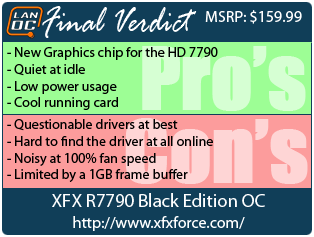 The AMD product lineup had a small hole in it for a long time between the HD 7770 and the HD 7850. We heard a few rumors about the possibility of an HD 7790 or an HD 7830 and just after LanOC V12 AMD launched their answer the HD 7790. We are a little late to the party, but we have had time to put ours to the test with our revamped benchmark suit that features the latest games. Let’s take a look at how it performs compared to AMD’s other offerings as well as NVidia’s new GTX 650 Ti Boost. Is this a good time to pick up a new video card?
The AMD product lineup had a small hole in it for a long time between the HD 7770 and the HD 7850. We heard a few rumors about the possibility of an HD 7790 or an HD 7830 and just after LanOC V12 AMD launched their answer the HD 7790. We are a little late to the party, but we have had time to put ours to the test with our revamped benchmark suit that features the latest games. Let’s take a look at how it performs compared to AMD’s other offerings as well as NVidia’s new GTX 650 Ti Boost. Is this a good time to pick up a new video card?
Product Name: XFX R7790 Black Edition OC
Review Sample Provided by: XFX
Written by: Wes
Pictures by: Wes
What’s the HD 7790 all about
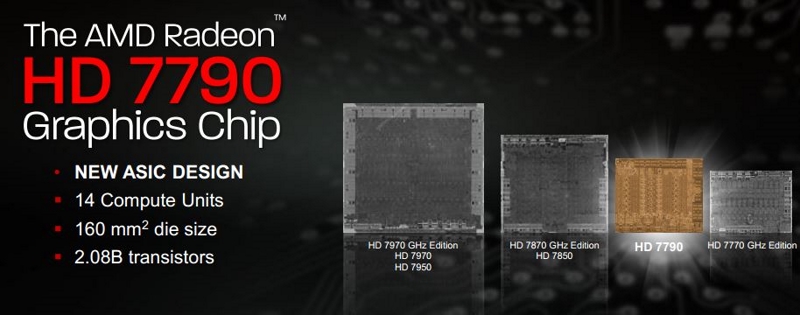
Before we jump into our review lets go over the details of the HD 7790. Nvidia put together their GTX 650 Ti Boost using a GTX 660 PCB and memory with a GTX 650 Ti Graphics Chip. AMD didn’t take that route though with the HD 7790. They actually put together a different Graphics Chip specifically for the HD 7790. This is obvious when taking a look at the specifications for the HD 7770, HD 7790, and HD 7850. The HD 7790 has 2.08 billion transistors while the HD 7770 has 1.5 and the HD 7850 has 2.8. Along with that the HD 7790 has 656 texture units over the 40 from the HD 7770 and the HD 7850’s 64. Where the HD 7790 does match the HD 7770 is with its Memory Interface. It has the same 128 bit interface with 1 gig of GDDR5. The HD 7850 does have the same 128 bit interface but with twice the ram it will have less issues with high resolutions and extremely demanding games.


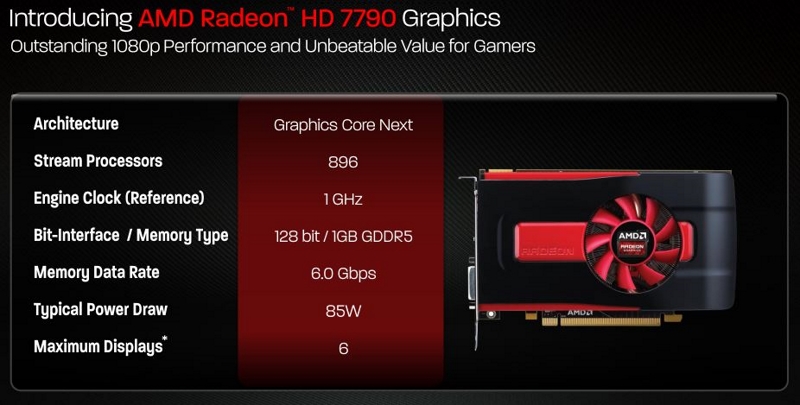
The HD 7790 is still based on AMD’s Graphics Core Next architecture as well as 28nm technology. You will get dual geometry and tessellation engines as well. Here is a breakdown of its architecture.

They did make another change with the HD 7790, a tweak to their AMD PowerTune Technology that dynamically overclocks your card on the fly. Previously PowerTune used four DPM states, low power, intermediate, high, and boost. Each would run different clock speeds and dynamically adjust voltage as needed. The HD 7790 had eight DPM states allowing for a better voltage selection as clock speeds ramp up. This doesn’t change the boost speed really but can play a big role in you getting the best performance in everyday use. What that means is with smaller steps it is more likely that there will be a power state that will fit the clock speed that you might be using, making it more efficient.
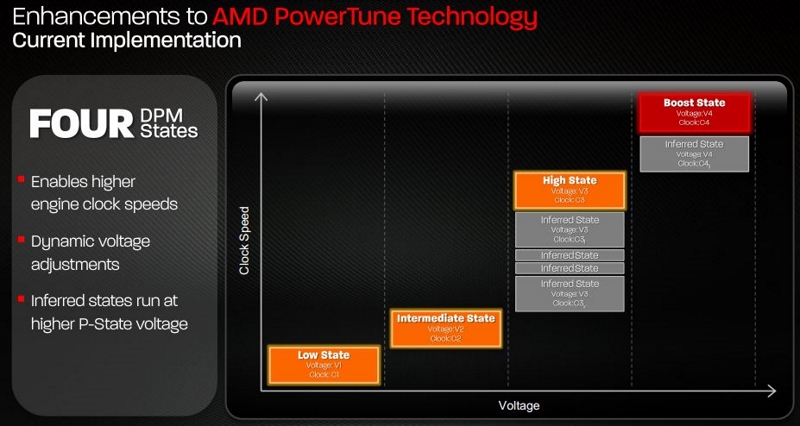
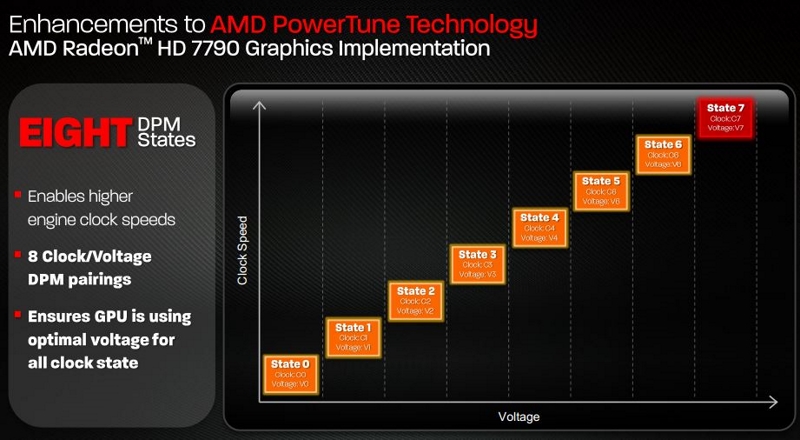
Specifications
|
Processor & Bus |
|
|
Chipset version |
ATI Radeon HD 7790 |
|
GPU Clock |
1075 MHz |
|
Memory |
|
|
Memory Bus |
128 bit |
|
Memory Clock |
6.4 GHz |
|
Memory Size |
1 GB |
|
Memory Type |
DDR5 |
|
Feature Technologies |
|
|
AMD Eyefinity Technology |
Yes |
|
AMD HD3D Technology |
Yes |
|
Other Features |
|
|
AMD - CrossFire ready |
Yes |
|
Display Output |
|
|
Display Port ready |
1.2 |
|
Dual link Support |
Yes |
|
HDMI Ready |
1.4a |
|
Max Supported Resolution (ANALOG) |
2048 x 1536 |
|
Max Supported Resolution (DIGITAL) |
2560 x 1600 (DVI); 4096 x 2160 (HDMI;DP) |
|
Output - DL-DVI-I |
1 |
|
Output - HDMI |
1 |
|
Physical |
|
|
Card Dimension (cm) |
19.8 x 11.12 x 3.81 |
|
Card Dimension (inch) |
7.8 x 4.4 x 1.5 |
|
Card Profile |
Dual |
|
Thermal Solution |
Dual Fan with Ghost Thermal |
|
Thermal Type |
Dual slot |
|
Includes |
Driver CD Installation Guide : 1 Installation CD with Multi-Language User Guide : 1 Promotional Bundles : PSU Cross marketing Quick Installation Guide : 1 XFX BE badge : 1 XFX Serial Number Door Hanger : 1 |
|
Requirements |
External Power - 6-Pins : 1 XFX Recommended Power Supply : XFX 550W PSU |
Packaging
The R7790’s packaging has the same theme as all of the previous XFX cards we have seen. Across the fron you have a large XFX logo grabbing your attention. Personally I think a picture of one of their Black Edition cards would really catch your eye here, but it does lock the packaging down to just a few models. The box itself is the smaller design that we saw last time from XFX, their box for the R7770 used to be large just like the R7970. They still take advantage of the box and cover the rest of the front with a few details on the card as well as details on what makes this a Black Edition card. Up on the top of the card you will also spot our LanOC awards right up top pointing out that the 7000 series cards have received awards from us previously. Around back there is more information on the R7790. Most of the information is the same information that we have seen on previous cards but I did spot a section called Power Tune 2. This talks about the new 8 power states and how AMD handles the PowerTune on the new 7790 cards.



Inside we have the card wrapped up in a static protective bag and tucked into cardboard for protection. Along with the video card we had a whole stack of paperwork from XFX. You get quick installation guides, information on XFX power supplies, information on adapters, a warning letting you know you can only hook up a DVI to VGA adapter on one port, and a drive disc. Like other XFX cards this also came with a Do Not Disturb door hanger that has your cards serial number on the back along with the contact info for customer support should you have any trouble in the future. It’s a small touch but I love it every time, it’s much better that having to dig the card out of your computer to get the serial number. You also get XFX’s crazy black edition case badge that is both metal and black plastic.




Card Layout and Pictures
As with all of the other 7000 series cards with the DD aka double dissipation badges from XFX this card has that great looking aluminum design with two cooling fans. They put a nice flat black stripe up the side of the card that brings the fans together and gives the card a little style. On the top we have a red strip across the top of the card with the XFX logo and in this case is says R7700 Series. On previous cards it would actually say the model that you went with, I’m not a big fan of this general branding here. If it was me I would want everyone to see that I have the R7790, not the R7750.



Although I love the dual fan cooling design and the heatpipe design that is pulling heat out and away from the GPU for cooling. I always prefer when we see a design that also integrates a way to vent all of that heat out of the case. In most cases with two fans there is just too much air to be able to push it out of the back. In this case you can see the entire bottom is open as well as most of the top and the entire end. That means most if not all of the heat from the card will vent into the case. This isn’t a big deal generally but it is something to keep in mind, it is enough to heat up a case that already has a ventilation issue.



I love the all black PCB on the R7790, this is going to be very visible and this is a great touch. For being a budget card it’s great to see that they didn’t skimp out here. We can also see that this card does have a single crossfire port up top as well so there is the possibility of pairing up two of these for more power in the future.

The R7790’s connections consist of two dual link DVI ports, and HDMI port, and a full sized DisplayPort. The paperwork we saw in the box also noted that you can only use one port for a DVI to VGA adapter, the second port is a full digital. I love that the vent has the XFX logo cut out of it.

Our Test Rig
Asus Rampage IV X79 Motherboard
Seagate Constellation 2tb Hard drive
Cooler Master Gold Series 1200 Watt PSU
http://www.highspeedpc.com/ Test Bench
Kingston 1600Mhz DDR3 Quad Channel Ram
Kingston Hyper X 120 SSD
Our Testing Procedures
Bioshock Infinite Using the Adrenaline Action Benchmark Tool we run Bioshock Infinite on the “Xtreme” quality setting. This has a resolution of 1920x1080, FXAA turned on, Ultra Texture detail, 16x Aniso Texture Filtering, Ultra Dynamic Shadows, Normal Postprocessing, Light Shafts on, Ambient Occlusion set to ultra, and the Level of Detail set to Ultra as well.
Tomb Raider Using the Adrenaline Action Benchmark Tool we run Tomb Raider on the “Xtreme” quality setting. This has a resolution of 1920x1080, Exclusive Fullscreen turned on, Anti-Aliasing set to 2xSSAA, Texture Quality set to Ultra, Texture Aniso set to 16x Aniso, Hair Quality set to TressFX, Shadow set to Normal, Shadow Resolution on High, Ultra SSAO, Ultra Depth of Field, High Reflection quality, Ultra LOD scale, Post Processing On, High Precision RT turned on, and Tessellation is also turned on.
Hitman: Absolution Using the Adrenaline Action Benchmark Tool we run Hitman: Absolution on the “Xtreme” quality setting other than the MSAA setting is turned down from 8x to 2x. That setting puts the resolution at 1920x1080, MSAA is set to 2x, Texture Quality is set to High, Texture Aniso is set to 16x, Shadows are on Ultra, SSA is set to high, Global Illumination is turned on, Reflections are set to High, FXAA is on, Level of Detail is set to Ultra, Depth of Field is high, Tessellation is turned on, and Bloom is set to normal.
Sleeping Dogs Using the Adrenaline Action Benchmark Tool we run Sleeping Dogs on the “Xtreme” quality setting. That means our resolution is set to 1920x1080, Anti-Aliasing is set to Extreme, Texture Quality is set to High-Res, Shadow Quality is High, Shadow Filter is set to high, SSAO is set to High, Motion Blur Level is set to High, and World Density is set to Extreme.
F1 2012 We use the built in benchmark for F1 2012. We set our resolution to 1920x1080 and then use the “Ultra” setting.
Batman Arkham Asylum We used the built-in benchmark set to 1920 x 1080, Multi Sample AA 16XQ, Detail Level, Very High, Bloom: Yes, Dynamic Shadows: Yes, Motion Blur: Yes, Distortion: Yes, Fog Volumes: Yes, Spherical Harmonic Lighting: Yes, Ambient Occlusion: Yes, PhysX: Off
Total War: Shogun 2 Direct X11 Benchmark High setting
Crysis 2 Using Adrenaline Crysis 2 benchmark. 1080p, 4x Anti-Aliasing, DX11, Laplace Edge Detection Edge AA, on the Times Square map, with hi res textures turned on.
Battlefield 3 Using Fraps with the game set to Ultra settings with 4x MSAA Antialiasing Deferred, 16X Anisotropic Filter, at 1920x1080.
Sniper V2 Elite 1920 x 1080 resolution, graphics detail set to ultra
Dirt Showdown 1920 x 1080 resolution, 4x MSAA multisampling, Vsync off, Shadows: ultra; Post Process: High; Night Lighting: High; Vehicle Reflections: Ultra; Ambient Occlusion: Ultra; Water: high; Objects: Ultra; Trees: Ultra; Crowd: Ultra; Ground Cover: High.
Synthetic Benchmarks For video cards our synthetic benchmarks are limited to 3DMark Vantage 2011, and 3DMark 2013 (AKA 3DMark). In 3DMark Vantage 2011 we run both performance and extreme benchmarks. The same goes for the most current version of 3DMark, we run through Fire Strike on standard and extreme settings.
Unreal Heaven Benchmark 4.0 Using the “Extreme” preset
Unreal Heaven Benchmark 4.0 heat testing We run through Unreal Heaven at 1080p for 30 minutes to test in game heat performance and noise output of the card while under load.
Power Usage Using Unreal Heaven Benchmark 4.0, we get our “load” power usage number from the peak power usage during our test. We get our numbers from a Kill-A-Watt connected to the test benches power cord.
Noise Testing Our Noise testing is done using a decibel meter 3 inches away from the video card on the bottom/fan side of the card. We test an idle noise level and then to get an idea of how loud the card will get if it warms all the way up we also turn the fan speed up to 100% and test again. The 100% test isn’t a representation of typical in game noise levels, but it will show you how loud a card can be if you run it at its highest setting or if it gets very hot.
Cooling, Noise, and Power
Along with new game benchmarks we also changed how we handle cooling and noise testing and added power usage testing as well. For cooling testing we switched to the Heaven 4.0 benchmark and we let it run for a half hour under the same “extreme” preset that we do on the Heaven 4.0 benchmark. This will warm the card up in a similar way to what you should expect to see in the average game. Our results are finally starting to fill in with our new benchmarks due to some retesting of old cards in addition to cards like the Diamond BizView that we just covered as well. With two fans I had high hopes for the R7790 but I have had a few issues with some XFX cards getting a little warm. It looks like they have adjusted the fan profiles to fix this and the R7790 performed perfectly with it being a little warmer than the GTX 650 Ti Boost from MSI, but still MUCH better than the reference cards in our test as well.

For noise testing we changed things up as well to a less subjective test using a decibel meter. We hold the meter three inches away from the fan side of the card on an open test bench. Your experience in a closed case should be lower. We do the test at an idle state as well as with the fan turned up to 100%. This is basically a minimum and maximum situation, your in-game noise levels will fall in between depending on how much load the game puts on the card itself. Idle loads are done the same way but out of game in windows at idle. At idle the XFX R7790 Black Edition was the quietest card tested at 60.9 db. With the fan turned up to 100% it didn’t fare as well with it putting out 72 db. It should also be noted that my wife actually came into the office asking what the noise was as well. I wouldn’t recommend cranking the fans all the way up on this one, but of course with the results earlier for cooling we know that you won’t need to turn them all the way up either.
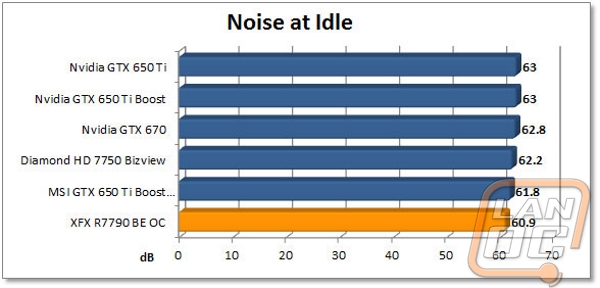
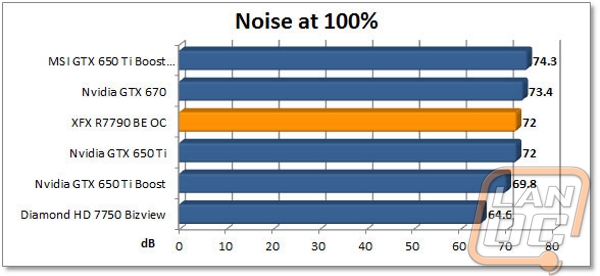
Our new power consumption testing uses the same Heaven 4.0 benchmark to put a load on the card while watching for peak power draw using a Kill-a-watt hooked to our test bench. The total power usage is going to include the power needed to run our motherboard, 3960X CPU, hard drive, SSD, and water cooling on top of the video card itself. I was really curious where the power usage for the R7790 would come out being our first HD 7790 tested. At idle it barely pulled any more wattage than our GTX 650 Ti and the tiny HD 7750 BizView that didn’t even require a 6 pin power connection. For under load wattage it came in just above those same two cards as well with 290 watts being pulled total, 29 watts less than the reference GTX 650 Ti Boost even!

Synthetic Benchmarks
Our new synthetic benchmark test suite is starting to fill in as well now in our 3DMark Fire Strike and Heaven 4.0 results. I did run into a testing issue with 3DMark Fire Strike on the extreme setting that went across multiple HD 7790’s so I haven’t included those results until we can confirm that it isn’t a driver issue, sadly we haven’t heard back from AMD on that though. Our results basically came in on par and sometimes even below the 300 score that we saw with the HD 7750 even. I expected the results to be considerably lower than the GTX 650 Ti Boost because of the smaller Memory Bit size as well as the overall smaller frame buffer size, but even with that in mind the results were too far off to consider keeping them permanently. I would highly recommend keeping an eye out for new driver releases for this card in the future though to fix those issues.
As for our other results, in the standard 3DMark Fire Strike test we had a 4051 graphics score that put our overclocked R7790 in over the reference design of the GTX 650 Ti Boost but below the overclocked MSI card. In our Unreal Heaven 4.0 benchmarks we saw the R7790 come in lower than both of the GTX 650 Ti Boost cards due to our Heaven 4.0 benchmark having the settings including AA turned up. It’s clear that the small frame buffer size can cause major issues for the R7790 in some cases.


3DMark 11 had similar results to Fire Strike with the R7790 coming in above the reference GTX 650 Ti Boost in the performance test but when the settings are turned up to extreme it pulls behind. In both cases it was just slightly behind the XFX R7850 Black Edition OC as well showing how perfectly the R7790 fits in between the 7770 cards and the 7850 cards.


In Game Benchmarks
The synthetic benchmarks are fine and dandy but when it comes down to it, it’s all about how it performs in game right? That is why we put the R7790 through a whole collection of games in our Test Suite to see how it performs. We are testing with a range of new and old games that should give you a good idea of what to expect. Of course I was very curious how the R7790 performed against the two GTX 650 Ti Boost’s that we recently have taken a look at. I was surprised that in a lot of the games the results were very close, generally on games that don’t need that 3 Gb frame buffer like Sleeping Dogs we had numbers just above the reference card and below the MSI. But in other cases you could tell that a little more frame buffer would come in handy like Bioshock Infinite. The results weren’t too bad but this card is certainly being held back. Games like Dirt Showdown and F1 2012 gave us over 60 FPS and many of the others came in close to 35-40 FPS. That is a playable FPS as a lot of console games has proven but if you are looking to smooth that out, most of our benchmarks could be turned down slightly without changing the detail in game while pushing the FPS up higher.











Overall and Final Verdict
I jumped into the XFX R7790 Black Edition OC review excited to check out a new XFX card as well as excited to take a first look at AMD’s new offering and the competition for the GTX 650 Ti Boost that I have covered multiple times over the past few weeks. Even after all of that excitement wore off I am still excited for these times. Both Nvidia and AMD have jumped back into a more competitive market recently with bundles, deals, and new models being introduced even before we get into new series as well. Because of that this is certainly a decent time to be looking at mid-range cards although I would be a little more worried about picking up a high end card at this point.
I love that AMD spent a little time on the HD 7790 and introduced a new card that isn’t just two cards patched together like Nvidia did. But having said that I think that this card is held back in many cases by its limited frame buffer. In order for AMD to keep up they will have to bring out a 2 Gb card to compete better with the GTX 650 Ti Boost 2Gb. Another issue that I ran into while testing this card was its driver issues. Unlike most other launches, the HD 7790 has a driver that isn’t currently bundled into the normal AMD drivers. That means you have to search around to even find the proper driver after downloading the normal driver and having no luck. There isn’t any documentation available saying that you need a different driver unless you actually Google “HD 7790 driver”. On top of that we ran into issues with the driver in 3DMark Fire Strike Extreme that forced us to not even be able to include those results in our graphs.
Performance wise the R7790 did well in all of our benchmarks. I was especially impressed with its results in the power and cooling section. For an overclocked card with two fans they still managed to keep the power draw down. This will help make this a good card for people who don’t have a lot of extra power on their power supply in small OEM or store bought computers. At the end of the day I think the decision between the GTX 650 Ti Boost and the HD 7790 is going to come down to how much ram do you need and brand preference. The performance numbers jump back and forth with each winning a few and I don’t think you can go wrong with either one, especially once they update the drivers.
